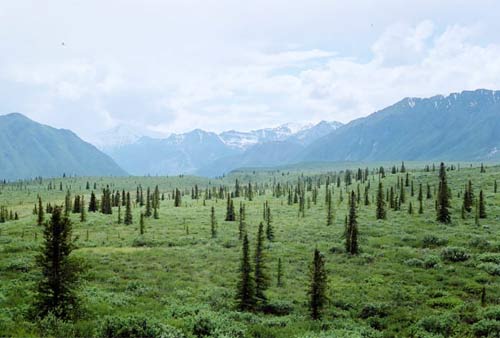Tree - new inhabitants of the Arctic!
The rise in temperature due to the warming of the earth caused the spruce forests to occupy the Arctic copper moss faster than the scientists imagined, chasing the creatures that only used to reside there.
Copper mosses are areas where trees are limited to growth by low temperatures and short growing seasons. In the Arctic, moss copper is dominated by permafrost. The only plant that can survive this harsh condition is grass, moss and lichen. Spruce forests are located near these mossy areas, and the border between them is called treeline.
In the summer, the permafrost layer dissolves, and copper moss begins to be covered by marshes and lakes, creating the only habitat for plants. However, climate change has extended warm summers and spurred tree growth, making the treeline deep into the moss.
When observing the tree cycle, researchers at the University of Alberta rebuilt 300 history of the position of treeline and tree density. The results showed that spruce was ingrained in the moss faster than their guess.
"It's like he waited until the right time and then decided to speed up and run, not just walk , " said author Ryan Danby.
While in many places, the more trees the better, this creates a danger for endemic North Pole species such as reindeer and sheep living on mosses, as well as indigenous peoples who depend on them. into these species to survive.

Spruce is encroaching into the Arctic. (Photo: Livescience)
T. An
- Visiting paradise island only 48 inhabitants live
- Interesting facts about animals living in the Arctic
- Russia first decoded DNA of ancient trunk
- The oldest tree in England has changed sex after 3,000 years
- Discover 300-year flowers in the Arctic
- Arctic sea ice area is at a record low
- Every second 14,000 tons of water flows into the sea because the Arctic ice melts
- The volume of ice in the Arctic drops to a record low
- Ancient trees have unique and strange shapes all over the world
- The Arctic lost three times as much ice as Belgium every day
- The extraordinary journey of the Arctic fox
- Arctic ice is melting record fast
 Is the magnetic North Pole shift dangerous to humanity?
Is the magnetic North Pole shift dangerous to humanity? Washington legalizes the recycling of human bodies into fertilizer
Washington legalizes the recycling of human bodies into fertilizer Lightning stone - the mysterious guest
Lightning stone - the mysterious guest Stunned by the mysterious sunset, strange appearance
Stunned by the mysterious sunset, strange appearance